Growth in the Treasure Valley in 2020
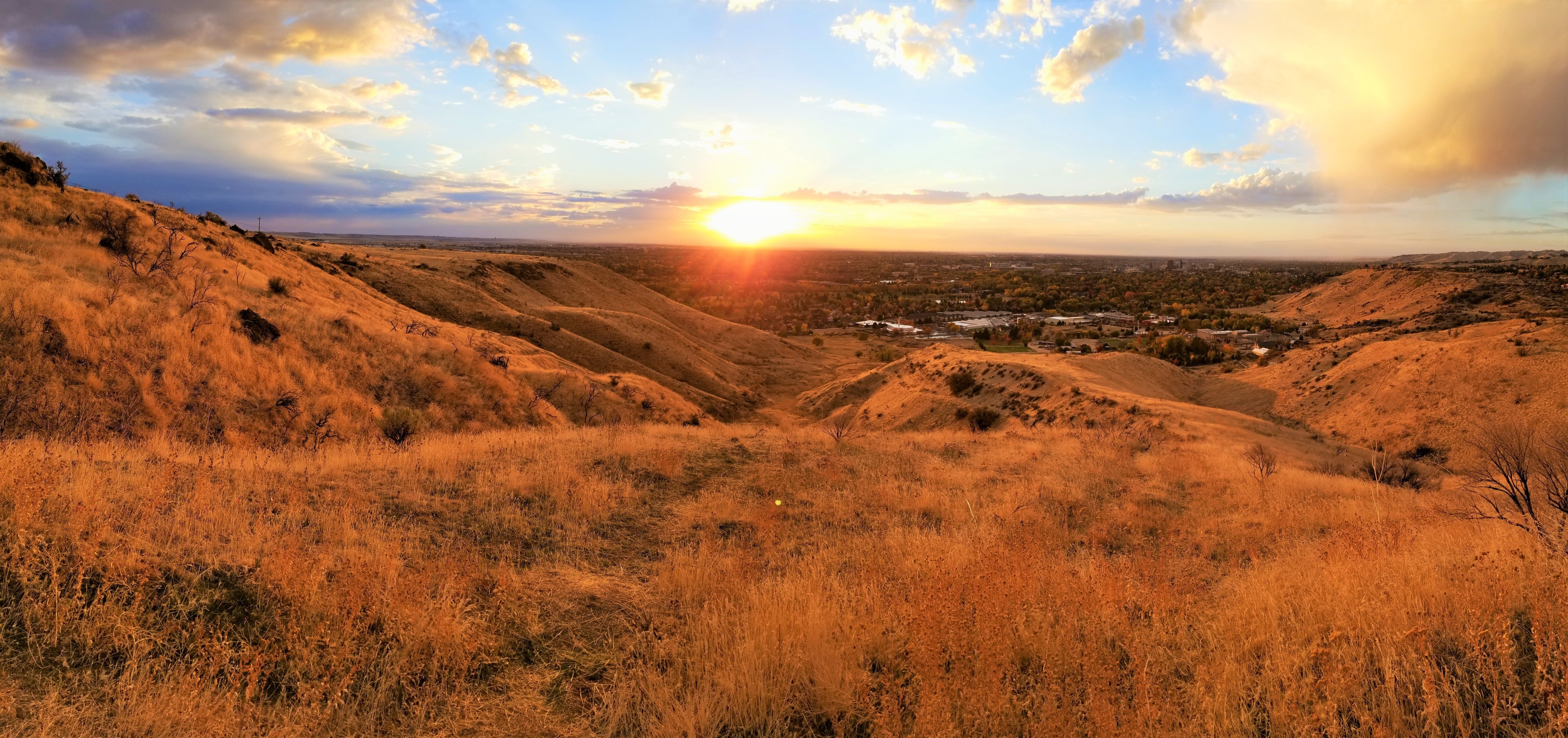 About the Survey
About the Survey
Report Authors
- Jeffrey Lyons, Director of Survey Research, School of Public Service
- Matthew May, Senior Research Associate, Idaho Policy Institute
The Sixth Annual Idaho Public Policy Survey
The Sixth Annual Idaho Public Policy Survey was conducted November 29-December 3, 2020, and surveyed 1,000 adults over the age of 18 who currently live in Idaho. The Treasure Valley was oversampled to survey 750 residents of Ada (66%), Canyon (27%), Gem (4%), Boise (4%), and Owyhee (1%) counties. The results here focus on this Treasure Valley sample. The sample is designed to be representative of the population of the region both geographically and demographically. This was a mixed-mode survey which contacted by phone (58%), online (32%), and via text message (10%). The goal of using multiple means to contact respondents is to increase our coverage of the population to people who may not respond to traditional phone surveys. The survey has a simple random sampling margin of error of +/- 3.6% for the Treasure Valley, and was conducted by GS Strategy Group.
Executive Summary
The Treasure Valley has experienced robust population growth in recent years, and by all accounts those trends only increased in 2020. Using survey responses from a geographically and demographically representative sample of 750 Treasure Valley residents, we explore their views on growth and some of the issues that it presents. We find that:
- A large majority of people believe that the Treasure Valley is growing too fast, a trend that has changed dramatically since we began asking this question in 2016. These concerns extend to some of the consequences of growth, especially with regard to the cost of housing and property taxes.
- Nearly half of the people in our sample reported that the cost of housing was placing a financial strain on their household, with renters feeling these effects more acutely than homeowners.
- Nearly half believe that property taxes are too high, with a majority expressing that their primary concern with regard to these taxes is their unpredictable nature.
- Growth has also impacted the region’s transportation needs. Although the COVID-19 pandemic has brought changes to commuting patterns in the region, with nearly half of workers reporting that they work from home at least part time.
While there are a host of benefits associated with growth, we find that residents of the Treasure Valley also have considerable concerns.
For more information, visit: boisestate.edu/sps/surveys/
Growth Overview
To assess general attitudes about growth in the Treasure Valley, respondents were asked whether they believed growth was occurring too fast, too slow, or about right. This is a question that has been asked on the Treasure Valley Survey in prior years so we are able to compare responses over time.

A large majority of Treasure Valley residents continue to express the view that the pace of growth is occurring too fast (78%), with much smaller shares believing the pace of growth is about right (16%) or too slow (2%). Sizeable majorities of both Republicans (86%) and Democrats (69%) believe that the Treasure Valley is growing too fast.1
______
1. The sample presented here differs from the previous Treasure Valley Survey in that we have fewer respondents (750 instead of 1,000), and they were contacted as a part of another survey (the Idaho Public Policy Survey). However, the sampling methodology is the same as the prior several years, so other than having a slightly higher margin of error in this year’s sample (3.6%) due to having fewer respondents, we should be able to make comparisons across the years.
New Arrivals
With the large number of people who are moving to the Treasure Valley, questions have been raised about who these new residents are. By comparing those who have arrived in Idaho during the last 10 years to those who have lived in Idaho for longer than 10 years, we can identify whether these groups are different from one another.
Some have asserted that retirees comprise a large share of the new residents. We compared the percent of retirees and currently employed among those who have moved to Idaho in the last 10 years with those who have lived here for a longer period of time.
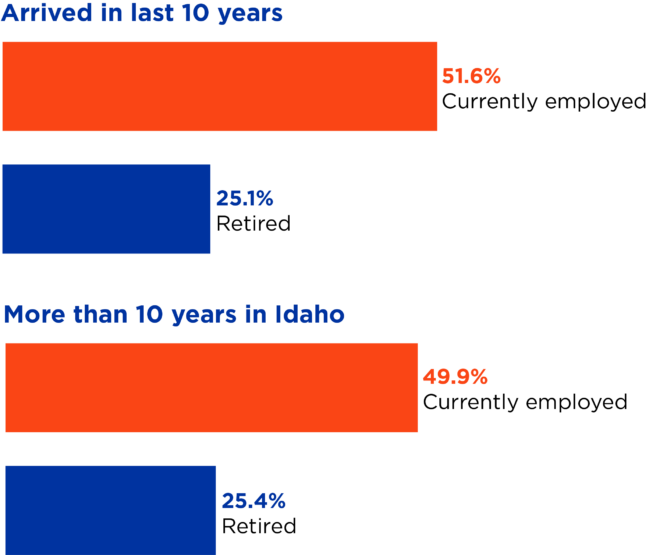
We find no significant differences between the recent arrivals and those who have lived here for a longer period of time. Roughly half of both groups are currently employed, while roughly one quarter of each group are retired. While it is still possible that there are larger shares of retirees moving to certain parts of the Treasure Valley, or from certain states, these results suggest that when we look at the Treasure Valley as a whole, the recent arrivals have very similar employment profiles to those who have lived here for a longer period of time.
This data also allows us to explore some of the attitudes of recent arrivals. Looking at party affiliation, we can see whether the share of Democrats, Independents, and Republicans is different when we compare recent arrivals to those who have lived here for longer.
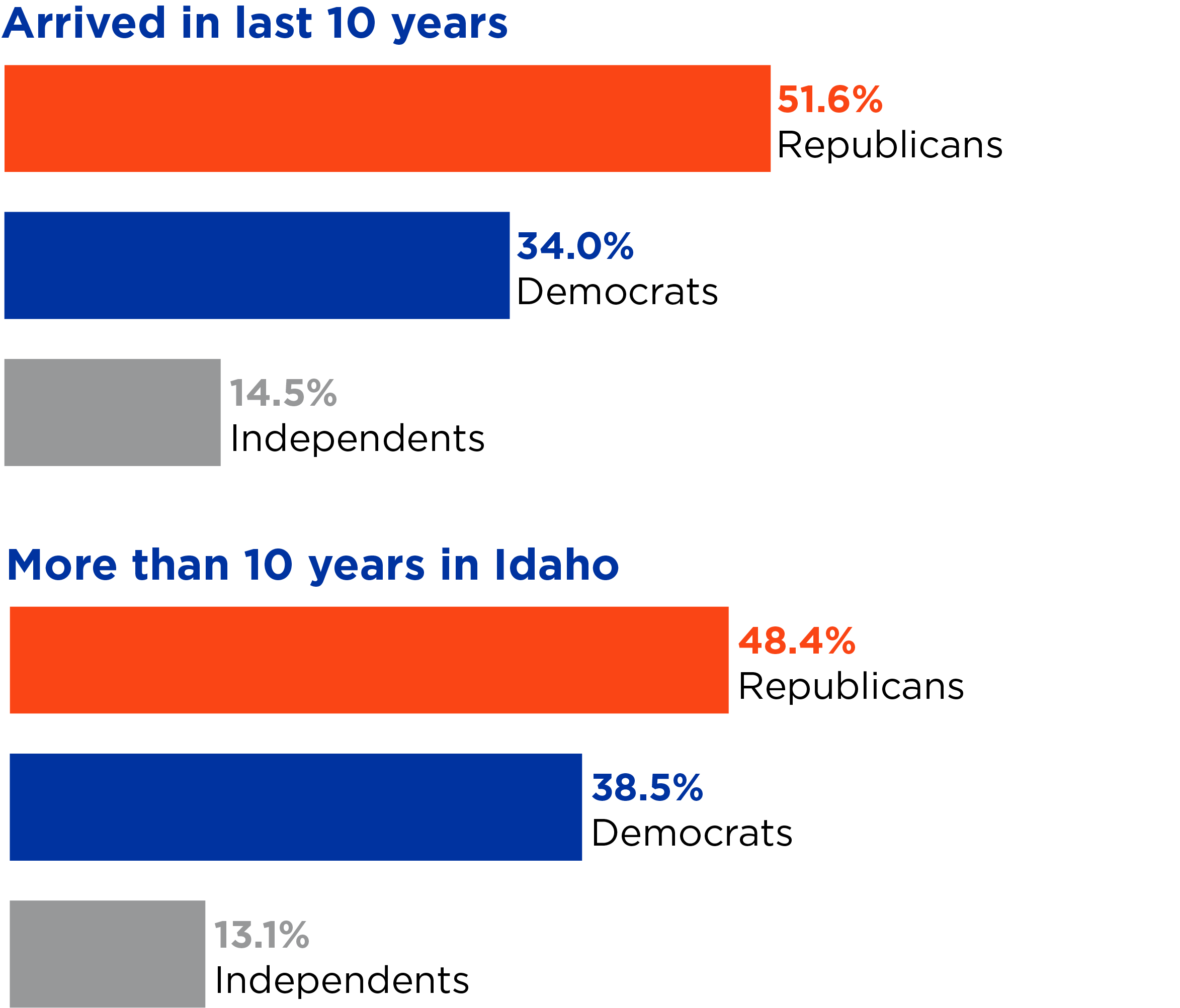
We find that there are no significant differences in the party affiliations of those who have recently arrived compared to those who have lived here for a longer time. Republicans are the largest group of both recent arrivals (52%) and long-term residents (48%), while Democrats comprise a smaller share of recent arrivals (34%) and long-term residents (39%).
_____
2. To make comparisons on the graphs easier, we have excluded other employment categories such as student, homemaker, unemployed, laid off, or disabled.
3. Those who identified with a third party or did not know their party affiliation have been excluded from the following calculations.
Taxes
The survey included a series of questions about property taxes. First, respondents were asked whether they believed that property taxes in Idaho are too high, too low, or about right.

Treasure Valley residents are fairly split in their assessment of property tax levels, with most indicating they are either too high (45%) or about right (40%). Few believe property taxes are too low (3%). When broken down by party, a higher percentage of Republicans (51%) responded that property taxes are too high than Democrats (37%).
Respondents were asked what their biggest concern was about residential property taxes and were presented with five options – the unpredictability of taxes due to the values of homes increasing, additional bonds and levies for schools and other taxing districts, local budget increases as allowed under state law, the current dollar limits of homeowners’ exemptions, and no concerns.
Over half of respondents (51%) identified the unpredictability of taxes due to rising home values as their biggest concern. The remaining options each accounted for a relatively small share of Treasure Valley residents, with additional bonds and levies (13%) being the second largest concern, followed by no concerns about property taxes (12%), dollar limits on homeowners’ exemptions (9%), and local budget increases (6%). Democrats and Republicans generally had very similar views on the biggest concern.
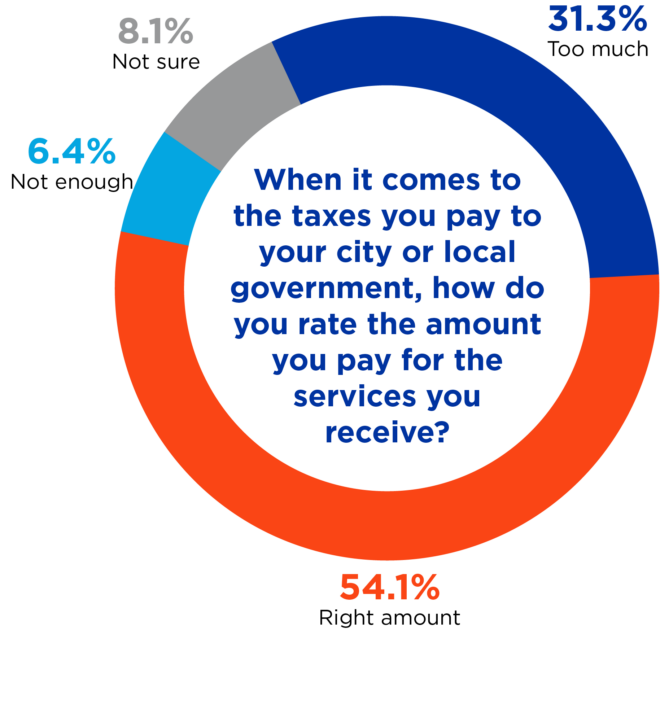
Finally, we asked respondents how they would rate the amount they pay in taxes to their city or local government compared to the services that they receive.
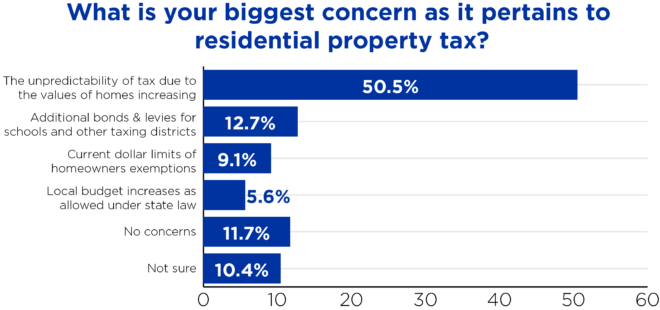
A majority of respondents (54%) reported feeling they pay the right amount in taxes for the services that they receive, while about one-third (31%) feel that they are paying too much. Very few (6%) reported that they were not paying enough. Majorities of both Democrats (65%) and Republicans (53%) indicated that the amount they pay for services was about right.
Housing
Housing costs have risen rapidly across the Treasure Valley in recent years, raising questions about the burden that these higher prices are putting on residents. Respondents were asked whether the cost of their housing places a financial strain on their household. Slightly over half (53%) of respondents indicated that the cost of housing did not place a financial strain on their household, while a sizeable minority (44%) indicated that it did—21% saying it was a lot of strain, whereas 25% say it was a little strain. There are large differences between those who rent and those who own their own home. Among renters, 81% report experiencing financial strain from housing costs, while 33% of those who own their home do.

Treasure Valley residents were also asked if they had to move out of their home today for whatever reason, how likely was it that they would be able to find a similar home for the same amount? A large majority (81%) responded that it would be either somewhat or very unlikely for them to find similar housing for the same amount of money, while relatively few (17%) believe they would be able to do so. We find minimal differences across renters and owners in their perceptions of finding comparable housing if they had to leave their current residence.
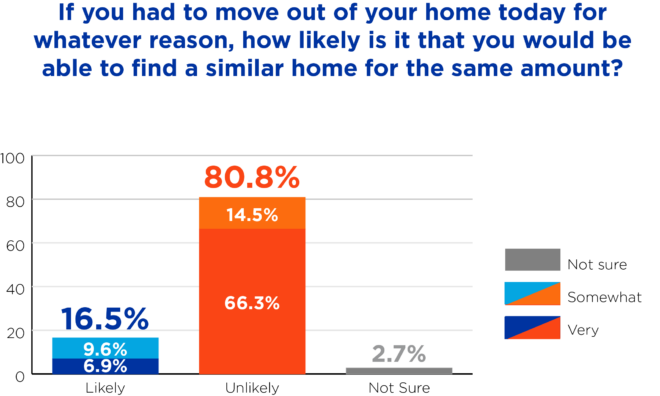
Transportation
COVID-19 has had a sizeable impact on work and commuting patterns throughout the Treasure Valley and has raised the prospect of more remote work in the future, potentially decreasing traffic congestion during commute hours. A little over half of our sample (51%) reported being currently employed. We asked these individuals whether they commute to work full time, work from home full time, or do a mix of the two.
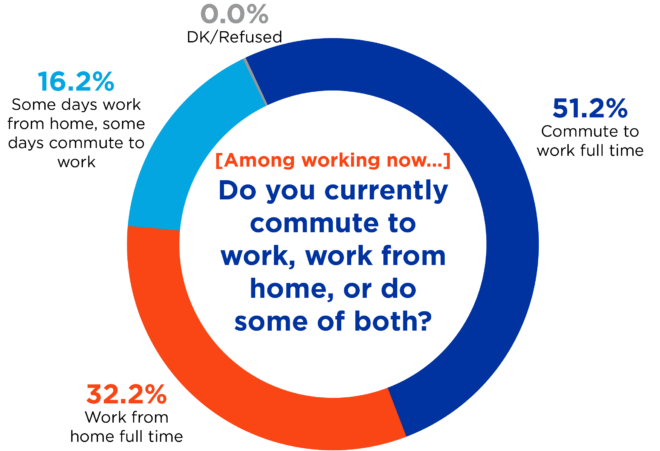
Of those who are currently employed, which is 379 respondents, a slight majority (51%) reported commuting to work full time, while roughly one-third (32%) said they were working from home full time. A relatively small share (16%) reported doing a mix of both commuting and working from home. Taken together, that means just under half (48%) of currently employed Treasure Valley residents are working from home on either a full- or part-time basis.

We asked the 48% who indicated they were working from home full- or part-time, 185 respondents, whether their remote work was a result of the COVID-19 pandemic. A majority of them (63%) report that COVID-19 is the reason that they are working remotely, while the remaining 37% say it is not the reason.
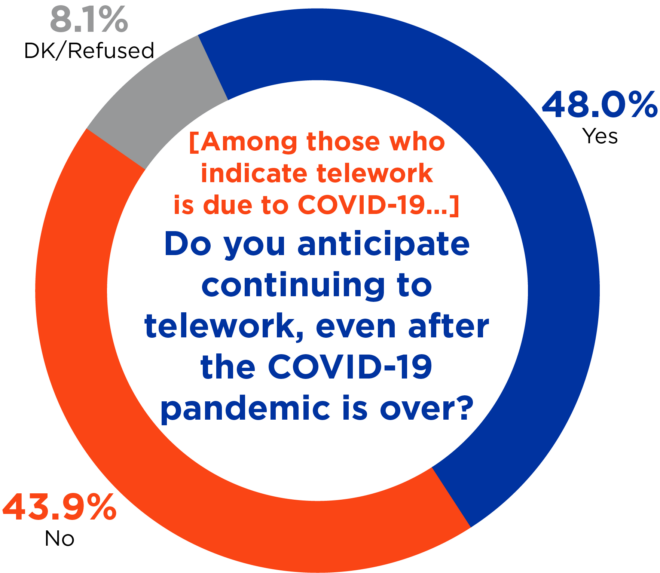
We asked those who reported working from home due to COVID-19, 116 respondents, whether they anticipated continuing to telework even after the pandemic is over. People are relatively split in their assessments of future teleworking – with 48% of those currently teleworking saying that they believe they will continue to telework after the pandemic, while 44% say they will not.
Conclusion
In sum, a large majority of Treasure Valley residents remain concerned by the pace of growth. While growth can bring a number of benefits, we find that people are concerned with the costs of housing, and also with taxes. Housing costs appear to be straining the budgets of a large share of people, especially for renters. While most people believe that they are paying about the right amount in taxes for the services they receive, almost half of the Treasure Valley residents think that property taxes are too high. There is no doubt that growth is presenting challenges to people across the region. Exploring the attitudes and experiences that people are having with these issues can hopefully help decision makers tackle the issues facing the Treasure Valley.
________
Idaho Policy Institute at Boise State University works across the state with public, private and nonprofit entities. We help articulate your needs, create a research plan to address those needs and present practical data that allows for evidence based decision making. We leverage the skills of experienced researchers and subject-matter experts to respond to the growing demands of Idaho communities.
Recommended citation: Lyons, J. & May, M. (2021). Growth in the Treasure Valley in 2020. Idaho Policy Institute, Boise State University.